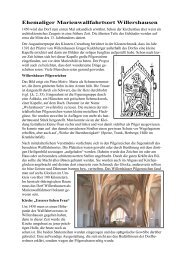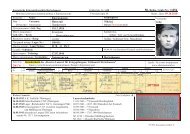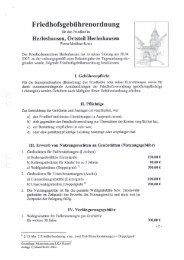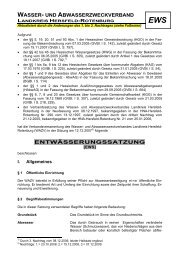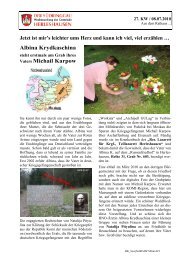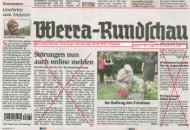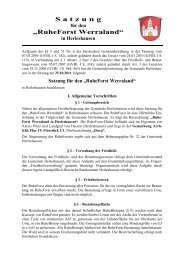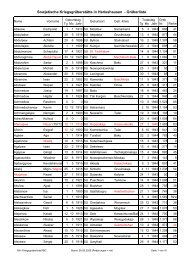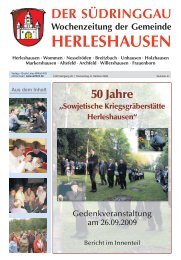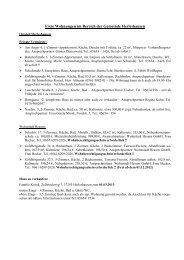Soviet War Memorial Herleshausen
Soviet War Memorial Herleshausen
Soviet War Memorial Herleshausen
You also want an ePaper? Increase the reach of your titles
YUMPU automatically turns print PDFs into web optimized ePapers that Google loves.
<strong>Soviet</strong> <strong>War</strong> <strong>Memorial</strong> <strong>Herleshausen</strong> (2007.10.26)<br />
”Viktor Nowikow”, student, born in Moskow,<br />
died in <strong>Herleshausen</strong>, 22 years old, buried on<br />
December 27, 1944 in row 56, grave no. 1322”<br />
This is one of 1593 entries in the <strong>Herleshausen</strong><br />
registry office’s register of the deceased which the<br />
then mayor and registrar Karl Fehr kept in<br />
opposition to the wishes of the SS-leadership in<br />
Eisenach and Berlin. Nearly everywhere in<br />
Germany soviet prisoners of war were buried<br />
outside of cemeteries or outside of prisoner camps<br />
without any record being made of their names.<br />
They suffered the fate of the many who were<br />
viewed by the inhuman ideology of the NS-regime<br />
as unfit to live, a regime that even treated the dead<br />
in an unworthy manner.<br />
Mayor Fehr remained firm, even though it was<br />
potentially quite dangerous for him, and insisted<br />
on receiving death certificates from each doctor of<br />
the camp ‘Stalag IX B’, as it was regulated by the<br />
Prussian Registration Laws which had not been<br />
eradicated by the rulers in command. ”Whoever<br />
dies in my community will be registered properly<br />
and receive a decent burial”, was his moral claim.<br />
Karl Fehr was not acting purely out of a<br />
courageous sense of duty but as a compassionate<br />
human being: ”When I left home in my youth to<br />
fight in the First World <strong>War</strong> my mother said to me:<br />
My boy, don’t forget that the French and the<br />
Russians also have mothers at home who are just<br />
as distressed and fearful as I am for you.” These<br />
were his words to warrant his efforts for the <strong>Soviet</strong><br />
prisoners of war, a truly courageous and admirable<br />
stance to take. He never viewed his endeavour as<br />
a personal achievement. Far too distinct was his<br />
memory of how intensely his mother had suffered<br />
after his brother Heinrich never returned from the<br />
First World <strong>War</strong>.<br />
Karl Fehr, born 1890, died 1973, registrar (1926<br />
- 1956) and mayor (1924 – 1945 / 1948 -1956) of<br />
<strong>Herleshausen</strong>.<br />
After the Second World <strong>War</strong> Mayor Fehr was the<br />
only registrar in Germany who could furnish a<br />
complete list of all the names and dates of the<br />
deceased prisoners of war who had, thanks to<br />
him, received a decent burial, and could then hand<br />
this list over to the ‘Volksbund Deutsche<br />
Kriegsgräberfürsorge’. The Volksbund was thus<br />
able to give the families in the <strong>Soviet</strong> Union the<br />
certain news of the death of their next of kin who<br />
were up to this point merely believed to be missing<br />
in action.<br />
Through means generated by the Volksbund,<br />
gathered by members and benefactors, a worthy<br />
last resting-place was planned and completed.<br />
The surrounding wall and the entrance area was<br />
built of the same red sandstone that was primarily<br />
used to build the Autobahn viaduct close to the<br />
camp.<br />
The <strong>Memorial</strong> Cemetery was officially inaugurated<br />
on September 26, 1959 as it can be seen today.
This commemorative ceremony was attended by<br />
representatives of public life, among them also the<br />
then <strong>Soviet</strong> Ambassador in Bonn. A Russian-<br />
Orthodox priest who visited the cemetery in 1960<br />
gave the site his blessing.<br />
Foto: ~1957<br />
Karl Fehr was honored in 1967 with the<br />
Bundesverdienstkreuz. To him the many letters<br />
from the relatives of the soviet prisoners of war<br />
buried here were of far greater significance. Viktor<br />
Nowikow’s mother wrote: ”I cannot find the words<br />
to thank you for the thoughtfulness that you gave<br />
an old mother who has lost her beloved child. My<br />
eyes are never dry when I look at the photograph<br />
of my son’s gravestone. I send you my motherly<br />
gratitude for your efforts in the interest of my son<br />
Viktor and myself. How much pain the war has<br />
inflicted upon the mothers, the women, the fathers<br />
and the children ...”.<br />
The last letter that Karl Fehr received from the<br />
<strong>Soviet</strong> Union (he died in 1973 at the age of 83)<br />
came to him out of the Ukraine: ”I would have liked<br />
to have sent a bit of money for the upkeep of my<br />
father’s grave. Most of all I would like to come to<br />
<strong>Herleshausen</strong> myself if only that were possible ...<br />
Instead I am sending you some flower seeds. I’m<br />
not sure whether you know these flowers in<br />
Germany. They are flowers that develop big black<br />
oilseeds in late summer. We have them<br />
everywhere here in the Ukraine and my father<br />
always loved them so much ...”<br />
In the following year, sunflowers were blooming on<br />
Iwan Antonow’s grave.<br />
To this day and thanks to the services of the<br />
German Red Cross and the Volksbund letters still<br />
arrive in <strong>Herleshausen</strong> with requests for pictures of<br />
the cemetery and of the graves of the beloved<br />
ones. On July 13, 1971 Maria Loginowa Tkatsch<br />
from Odessa stood at her father’s grave. She was<br />
the first relative of a war victim to receive a visa for<br />
the trip to Germany: ”Unfortunately I can only tell<br />
<strong>Soviet</strong> <strong>War</strong> <strong>Memorial</strong> <strong>Herleshausen</strong>/Germany<br />
2 (2007.10.26)<br />
you through a translator how I felt when I finally<br />
stood in the beautiful forest cemetery. In the name<br />
of my mother, my siblings and all of my relatives I<br />
want to say thank you for taking care of my<br />
father’s grave over all these years ..... If you were<br />
able to speak Russian you would be even better<br />
able to understand what I wanted to say to you.”<br />
This was how she said goodbye to the Volksbund<br />
who looked after her during her visit in Germany.<br />
Iman Zeinalow of Aserbeidschan with mayor<br />
Uwe Hartmann at his father’s grave in<br />
November 1985<br />
The ‘Glasnost era’ of Michail Gorbatschow made it<br />
possible for more relatives to visit the cemetery in<br />
<strong>Herleshausen</strong>. Among them was Imam Zeinalow<br />
of Aserbeidschan who paid his final tribute to his<br />
father with the Moslem ritual ceremony of<br />
scattering earth from his homeland over his<br />
father’s grave.<br />
The origin of the camp<br />
In 1938 when the Reichsautobahn by <strong>Herleshausen</strong><br />
was being built, several barracks camps<br />
were set up to house the workers. One of these<br />
camps, located on the road to Frauenborn, was<br />
taken over by the Wehrmacht in 1940 and<br />
established as a camp for prisoners of war.<br />
First french and later soviet prisoners were<br />
interned there and used for ground work at the<br />
autobahn building site. When tuberculosis broke<br />
out in Camp ‘Ramsborn’ near Eisenach the<br />
prisoners still able to work were moved out of<br />
<strong>Herleshausen</strong>.
The ailing soviet prisoners from Ramsborn were<br />
then transferred to the ‘Stalag IX B’ which was the<br />
official name for the camp on Frauenbörner<br />
Straße. Due to the progression of the illness and<br />
the lack of supplies and care it turned into the<br />
death camp for most of those interned there.<br />
These prisoners of war were not able to or even<br />
required to perform hard labor.<br />
The former prisoner-of-war camp ‘Stalag IX B’<br />
on Frauenbörner Straße; the <strong>Memorial</strong><br />
Cemetery is off to the right, behind the woods<br />
The first of the deceased were buried near the<br />
camp and later moved to the present memorial<br />
cemetery. The prisoners who survived the life in<br />
this camp were liberated on April 4 th , 1945 by the<br />
American troops and set out on their long way<br />
home.<br />
<strong>Soviet</strong> <strong>War</strong> <strong>Memorial</strong> <strong>Herleshausen</strong>/Germany<br />
3 (2007.10.26)<br />
A place for international encounters<br />
Through the endeavours of the Volksbund it was<br />
possible to motivate young people of various<br />
different nations to see to the maintenance and<br />
upkeep of <strong>War</strong> <strong>Memorial</strong> sites throughout Europe<br />
and Russia.<br />
Thus young people from Germany, Great Britain<br />
and Norway met in 1979 for their first work<br />
assignment at the <strong>Memorial</strong> Cemetery in<br />
<strong>Herleshausen</strong>. Meetings with youth groups of<br />
<strong>Herleshausen</strong>, time for contemplation, fun and<br />
social gatherings are part of the program for the<br />
annually held youth camps which are since 1988<br />
also joined by youth representatives from the<br />
various republics of the former <strong>Soviet</strong> Union.<br />
They always return, other nations join them, meet<br />
with each other and are reminded of the terrible<br />
consequences of war which we all hope none of<br />
them will ever have to experience.<br />
In 1990 the young people stood stunned and<br />
horrified in the former concentration camp<br />
Buchenwald. Stunned by the inconceivable and<br />
reinforced in their conviction to strive towards their<br />
goal of friendship and reconciliation. They were<br />
there to help tear down and dismantle the innergerman<br />
fence close to <strong>Herleshausen</strong> - <strong>War</strong>tha.
An international youthgroup of the VDK at work,<br />
1990, Borderline <strong>Herleshausen</strong> - <strong>War</strong>tha<br />
Thanks to their recommendations the ”elders”, the<br />
former enemies, met and shook hands. <strong>Soviet</strong><br />
Veterans from Tambow (approx. 450km southeast<br />
of Moskow) came to <strong>Herleshausen</strong> in May of 1990<br />
and as early as July of the same year Germans<br />
visited prisoner of war cemeteries in the region<br />
around Tambow. Reconciliation at the graves!<br />
Veteran <strong>Soviet</strong>-Armed<br />
”<strong>War</strong> memorials are the great preachers of<br />
peace and their importance as such will<br />
continue to increase!” said Albert Schweitzer.<br />
In <strong>Herleshausen</strong> 1,593 victims of war continue to<br />
warn and admonish us with their names on their<br />
gravestones to never again allow war and hate in<br />
Europe or in the rest of the world.<br />
written by Helmut Schmidt, <strong>Herleshausen</strong> (1998),<br />
translation by Stephanie Shea, Heidelberg<br />
<strong>Soviet</strong> <strong>War</strong> <strong>Memorial</strong> <strong>Herleshausen</strong>/Germany<br />
4 (2007.10.26)<br />
Amendment<br />
50-year-old Nadjescha Drygina from Uglitsch/<br />
Wolga visited on 29.04.2006 the grave of her<br />
grandfather Iwan Skrebow. She accompanied a<br />
delegation of pupils including her nephew to the<br />
partner-borough Idstein/Taunus. They too<br />
scattered home-earth on the grave of Iwan and the<br />
great-grandchild took some earth to scatter on the<br />
grave of Iwan's wife “...for their souls to be<br />
reunited.”<br />
"Grandfather, I am so sorry, that I can only come<br />
to visit you now..." Nadjescha whose father<br />
received the message only 10 years ago that his<br />
father was entombed in <strong>Herleshausen</strong> speaks to<br />
him of her home in quiet dialogue, of her<br />
Babuschka who until her death hoped would come<br />
back, of her father the only son of Iwan who is at<br />
home, having to be looked after having had a<br />
apoplectic stroke and who is waiting for what they<br />
are going to tell him about <strong>Herleshausen</strong> and what<br />
they will show him on the many photographs they<br />
took. Tears roll down her cheeks and sprinkle the<br />
tomb slab. "Spasiwa..." again and again!<br />
Nadjeschda (in English "hope") will have a lot to<br />
tell. "Do swidanja".. until we meet again at<br />
<strong>Herleshausen</strong>... or on the German soldier's<br />
graveyard at Uglitsch! (translation by Klaus Horn;
<strong>Soviet</strong> <strong>War</strong> <strong>Memorial</strong> <strong>Herleshausen</strong>/Germany<br />
5 (2007.10.26)



